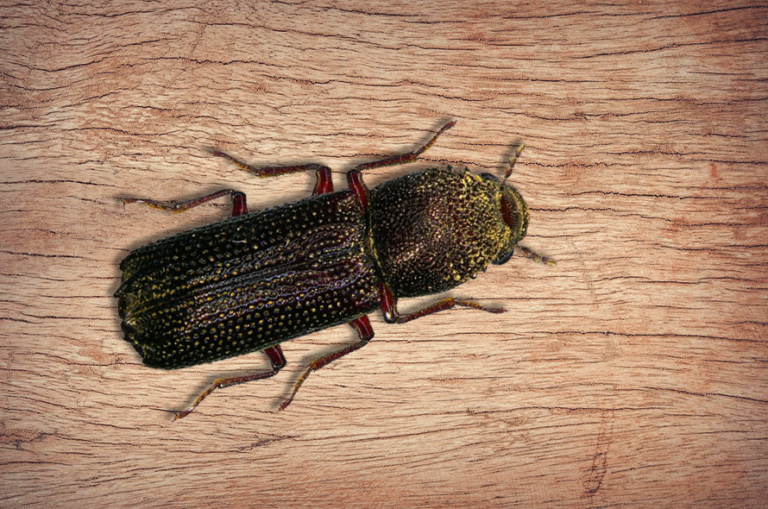
Bostrichid beetles
Bostrichid beetles, sometimes called false powderpost beetles, are a family of wood-boring beetles that primarily attack hardwood although some species will attack softwood.
Unlike anobiids and lyctids, bostrichid females are able to bore directly into the wood to lay their eggs.
The ability to correctly identify the type of beetle destroying the wood is a key step to treating and resolving the problem.
How to identify bostrichid beetles
Based on physical characteristics alone, bostrichid beetles have a few features that are similar to their anobiid and lyctid cousins. Bostrichids vary in size although those typically associated with wood boring are reddish-brown to black in color and measure ⅛ to ¼ inch long. When compared to lyctids, their bodies are less narrow and more cylindrical, although their size varies more than lyctids and anobiids. Similar to anobiids, their heads are tilted downwards with the pronotum covering it from above. Unlike anobiids, however, many bostrichid species have small bumps on the front of their pronotum, giving it a spiny, ridge-covered appearance. Like their cousins, bostrichid beetle larvae are white and C-shaped.
Another way to identify bostrichid beetles is by knowing where and what to look for. As previously mentioned, most bostrichids attack and feed on hardwood or bamboo, although some species will attack softwood. As bostrichids and lyctids tend to be similar in their habits, bostrichids are also unable to digest cellulose. Instead the larvae feed on the wood to obtain the sugar and starches found within in order to develop inside. Once fully developed, the new adult bostrichids bore holes through the wood creating round exit holes at least ⅛ inch in diameter. These holes are recognizable by the frass, tightly packed inside, which has a coarse texture and few, if any, pellets. Holes created by female bostrichids in order to lay eggs, on the other hand, will be powder-free.
Bostrichid beetle habits
Like lyctids (who consequently are a bostrichid subfamily), bostrichids usually attack wood with high levels of starch and moisture present. Since Bostrichids cannot digest the cellulose in wood like anobiids can, starch is the essential nutrient they are after. In order for females to lay their eggs, Bostrichids require wood to have a moisture content of at least 10%. This is because a certain level of moisture is necessary for the larvae to develop after hatching from eggs. Unlike anobiids and lyctids however, bostrichid females are actually capable of destroying wood. Rather than laying eggs on the surface of wood, they bore “egg tunnels” in which to deposit their eggs. Unlike the adult exit holes, these holes will be void of any frass. In ideal conditions, the average bostrichid life cycle takes around a year.
When conditions are right, first generations of bostrichids are capable of causing extensive damage to wood even within the first year. The high initial population numbers and rapid development allows the first generation to infest more wood, draining it of its nutrients. In some cases, if wood is completely drained of its nutrients, bostrichids won’t reinfest because there is nothing left. This damage can often be seen after the first generation emerges from the wood, leaving thousands of exit holes behind. Reinfestation is possible, however, if starch levels are too low or the wood is too dry, reinfestation will not occur.